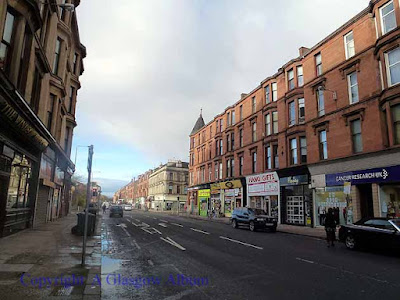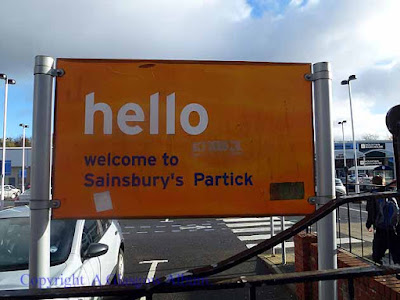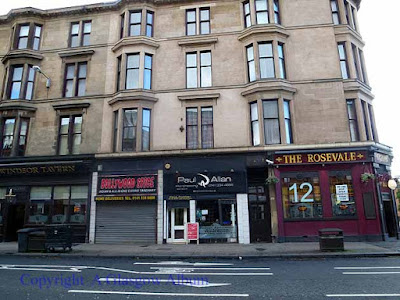http://glasgowalbum.blogspot.com/2010/02/introduction.html
Feel free to drop me an email with suggestions, offers of £20 notes etc. The address is damnyouebay@gmail.com. I have had to start watermarking the pics as I have come across one big website using a pic without permission - I suppose there must be others.
If you are a private individual and want to use any of the pics for non-commercial purposes please get in touch and I will usually be happy to say 'Aye' for free - just give the Album a credit. If you want to use a pic for commercial purposes a small mutually agreed fee and a credit will suffice.
Today is Thursday, 8 November 2012, and we are going to take a wee stroll from Partick Underground along Dumbartion Rd to the shopping centre at Crow Rd
 |
| Up the escalator we go. . . |
 |
| . . .into Partick Station |
 |
| Ranald MacColl's fine statue of Bud Neill's GI Bride |
 |
| For the companion statue - and more on the great Bud Neill - see Lobey Dosser Day http://glasgowalbum.blogspot.com/2010/06/lobey-dosser-day.html |
 |
| Let's head out |
 |
| Emerging into Merkland St. . . |
 |
| . . .where buses gather to rest and graze for a while |
 |
| The light is gloriously vibrant. . . |
 |
| . . .unlike me |
 |
| Looking back at Partick Station |
 |
| On beautiful mornings like this - it is just after 11- we are reminded of the 'Glasgow Effect', summed up here by the admirable Carol Craig - http://www.centreforconfidence.co.uk/carolsblog.php?id=284&blogid=1 'The researchers found that most of the differences between 'Glasgow' and the rest of the country could be accounted for by socio-economic and other variable such as deprivation. However there were four differences between 'Glasgow' and the rest of Scotland. The first is anxiety. Those living in 'Glasgow' had a '92% higher risk of anxiety than those living elsewhere' (after controlling for deprivation). Another difference was that people in "Glasgow'' had '42% increased odds of having a doctor-diagnosed heart attack' again after adjusting for socio-economic and other variables. "Glasgow ' folk also scored higher scores (worse) than those in the rest of Scotland on the General Health Questionnaire (GHQ-12). High scores can indicate 'possible psychiatric disorder'. Finally men in "Glasgow' were more likely to be overweight. There is one major flaw in this study which means that it is telling us practically nothing about 'the Glasgow effect'. The geographical unit used to compare the city with rest of Scotland is not Glasgow City, it is not even Greater Glasgow – including areas which are adjacent to the city such as Eastwood or Milngavie – but Greater Glasgow and Clyde Health Board Area. Apart from the City of Glasgow itself this includes: East Dunbartonshire, West Dunbartonshire, Renfrewshire, East Renfrewshire, South Lanarkshire, North Lanarkshire and Inverclyde. By no stretch of the imagination would people ever see Gourock, East Kilbride or Hamilton as Glasgow yet they are part of this study and being classed as 'Glasgow' for the purposes of the 'Glasgow Effect' title. In truth this report is a study of a densely populated part of the West of Scotland. What is being measured is not 'the Glasgow Effect' but 'the West of Scotland effect'. ' Great stuff - please do read the whole of Carol's piece. Partick and Calton - see http://glasgowalbum.blogspot.co.uk/2010/03/calton.html are very much the sort of areas people think of when they ponder 'the Glasgow Effect'. As pointed out in the Calton entry, there is some questionable World Health Organisation data going round; the death rate in Calton, for example, has been skewed by the presence of hostels in which single men from around Scotland find their way to, and where they may well die. See the Bellgrove here (another fine day), where I once saw a man die on the pavement - http://glasgowalbum.blogspot.co.uk/2011/04/welcome-to-glasgow-4-rutherglen-to_28.html |
 |
| Life |
 |
| Coming into Dumbarton Rd |
 |
| Looking east down towards Partick Cross - we will post some pics of that stretch of Dumbarton Rd at some point |
 |
| But we will be heading west under the railway bridge there |
 |
| Busy Partick Post Office - friendly staff |
 |
| Looking back down Merkland St |
 |
| Looking up Peel St, where you will find the West of Scotland Cricket Club; see http://glasgowalbum.blogspot.com/2010/03/cricket.html For Partick Burgh Hall (just round the corner there ) and a fine night in honour of Janey Buchan see http://glasgowalbum.blogspot.co.uk/2012/04/remembering-janey-buchan.html |
 |
| Support a Scottish Charity |
 |
| Mega Amusments |
 |
| The old pub over there (founded 1904) was the Hayburn Vaults until very recently - http://www.oldglasgowpubs.co.uk/hayburnvaults.html I hate it when they change pub names - especially to something as dull this |
 |
| Pressing on |
 |
| Poundland |
 |
| We'll cross back over here. . . |
 |
| . . . have a look down the lane |
 |
| U. S. A. Nails - American Designs |
 |
| Contented looking Buddha |
 |
| Looking back |
 |
| Beauty Solutions all in One |
 |
| Looking down Hayburn St - Clyde down there |
 |
| Credit Union, Cash4Clothes, white van, Oliver, lovemyclothes, Station Flowers |
 |
| A Holistic Spa |
 |
| The Windsor tavern. One of many Glasgow pubs bedecked in union jacks during the Olympics |
 |
| We're heading up Crow Rd over there |
 |
| Further down Dumbarton Rd is the end of an interesting walk - see South Street to Thornwood: an 'X'-Listed' walk in which we encounter the Secret State http://glasgowalbum.blogspot.com/2011/07/south-street-to-thornwood-x-listed-walk.html |
 |
| We have re-crossed Dumbarton Rd |
 |
| No Smoking during the sale of Bright Star Fireworks. What a useful sign |
 |
| Hello small person |
 |
| Looking up Crow Rd. About a mile or so up the road there is Anniesland - http://glasgowalbum.blogspot.com/2010/03/anniesland.html |
 |
| Coming up to Shopping Centre |
 |
| Partick Baptist Church |
 |
| Partick Free (Continuing) Church. The 'continuing' refers to the schism of a few decades ago. |
 |
 |
| Another sign up ahead. |
 |
| In this Sign Conquer |
 |
| Looking back down Crow Rd |
 |
| Sainsbury's ahead |
 |
| Faithful hound |
 |
| Back in Dumbarton Rd |
 |
| Bikes for sale |
 |
| Volunteers needed |
 |
| Roastit Bubbly Jocks Bistro |
 |
| Train overhead |
 |
| Back in Merkland St |
 |
| Top Prices Paid |
 |
| For Him |
Thank you for browsing, dear visitor. My other wee blogs are
http://parkeddogs.blogspot.com/
http://buddhasblackdog.blogspot.com/
Reviews of Scotland: 1000 Things You Need to Know
RADIO AND TELEVISON
'I love it - I'm giving this copy to a friend and buying another for myself' - Darren Adam, Presenter, Radio Forth, 17 November 2008
‘It’s a great wee book’ – Stephen Jardine, introducing Edwin Moore on Scottish Television’s Five-Thirty Show
'A fantastic book' - Scott Wilson , talk 107 Breakfast Show host
'A great read' - Dougie Jackson, Drivetime host, Smooth Radio 105.2
THE PRESS
'Despite its apparently humorous format, this is a serious and extensive dictionary on all things Scottish; from Jean Redpath to Lorne sausage, from Flodden to the Corries. Is particularly good on history and minutiae. There's a useful chapter on famous Scottish legal cases and another on literature. Excellent' - Royal Scottish Legion, Feb 2009
'This is the ultimate Scottish reference book' - Waterstones Christmas catalogue, 2008
'This is a fascinating look at the history of Scotland: its languages, politics and great achievements, from its origins in the ancient landmass of Laurentia 400 million years ago, to devolution and Billy Connolly. Edwin Moore has collected a thousand important facts about this beautiful country, covering Scottish history and culture, correcting misconceptions, and examining the mysteries of haggis and bagpipes with insight, warmth and impressive attention to detail' - The Good Book Guide, November 2008
'This is a recipe for revealing how horribly ill informed you are about your country. Although, if you are skillful, you can nod sagely as you read some new fact and mutter 'Ah, yes!' as if recalling the information from your excellent schooling. Where else will you find a real recipe for making haggis from scratch side by side with a potted biography of David Hume; a section of the Declaration of Arbroath and the curiously touching fact that Lulu was only 15 when she had a hit with 'Shout'? The whole thing is of course, silly - but oh so addictive.' - Matthew Perren, i-on Glasgow, December 2008
'. . . well crafted and witty' - Bill Howatson, Aberdeen Press and Journal, 18 October 2008
‘While most of Edwin’s entries are entertaining and scholarly – he writes like a Scottish Bill Bryson – it is when he takes an interest in the backwaters of history, the details lost down the back of the sofa, that he is at his best’ – Jack McKeown, The Courier, 27 October 2008
'History, it is said, is written by the victors. Trivia, meanwhile, is written by the guys with the smeared spectacles and the breathable rainwear. The first discipline is linear and causal; to quote from Alan Bennett’s play The History Boys, history is “just one f****** thing after another”. Things look different, though, when viewed through the prism of trivia. The past is reduced to one big coleslaw of fascinating facts that in their randomness tell a more mixed-up tale entirely.
The first approach leads to big, frowning books by the likes of Tom Devine and Michael Fry. The latter results in small, cheerful books such as Scotland: 1,000 Things You Need to Know, Edwin Moore’s valiant attempt to navigate the more trivial contours of enlightenment and clearances, crown and parliament, dirt and deity.
Moore proceeds from a sincere and controversial first principle: Scotland is really a rather pleasant and interesting place. . .As a work of popular scholarship, though, it’s in a different league to the Scottish novelty titles that get stocked next to the bookstore tills as potential impulse purchases, those little handbooks of parliamo Caledonia and regional braggadocio, such as Weegies vs Edinbuggers.' - Allan Brown The Sunday Times, 21 September 2008
'In his book, Scotland: 1000 Things You Need to Know, Edwin celebrates all that sets us Scots as a race apart - our language, law, flora, food, and of course, our people. From our poets, architects and inventors, to our artists, entertainers and fighters. But he doesn't shy away from the more unpleasant aspects of our history. . .' - Robert Wight, Sunday Post, 14 September 2008
‘We think we know all about William Wallace, Robert the Bruce and the Union of the Crowms. However, according to Edwin Moore, author of , Scotland: 1000 Things You Need to Know, we’re still in the dark about many aspects of our history and culture. . . The Big Issue looks at 20 of the most astonishing examples of secret Scotland.’ – The Big Issue, 18-24 September 2008
'What's the connection between Homer Simpson and Larbert, and why are generations of lawyers grateful to a Paisley snail? Need to know more? Author Edwin Moore has gathered 1000 facts like these about Scotland in a quirky new book. Brian Swanson selects a few favourites. . .' - Scottish Daily Express, 13 September 2008
'The palm for Christmas-stocking books seems to have passed recently to popular science, with best selling titles every year such as Why Don’t Penguins’ Feet Freeze? This year there has been a gallant attempt at a historical fight back. Scotland: 1,000 Things You Need to Know(Atlantic Books, £12.99) asks (and answers) such post-turkey questions as ‘How many kings of Scotland died in their beds?’, ‘Who on earth decided that the Declaration of Arbroath was the cornerstone of modern democracy?’ or ‘Why is iron brew spelled Irn-Bru?’ Mark Mazower,History Today; The Best of History in 2008, December 2008
'A real treat for the serendipitous Scotophile' - Reginald Hill
FROM THE INTERWEB
www.Booksfromscotland.com (on the new paperback edition)
Book of the Month, May 2010
'Whether it's Scottish lochs or Enlightenment philosophers, the facts of the devolution referendums or the mysteries of Irn-Bru, myths will be debunked and truths revealed in this light-hearted but rigorous overview of Scottish history and culture.'
Also available for download on Amazon's e-book store is my 100 Brief Encounters (only £3.06!)
http://www.amazon.co.uk/100-Brief-Encounters-ebook/dp/B006CQ8G84/ref=sr_1_1?s=books&ie=UTF8&qid=1322393003&sr=1-1
Here are some reviews of the print edition (published by Chambers in 2007) -
Edwin Moore's quirky collection of a hundred encounters between (mostly) important historical figures is a gem of a book. Where else could you get concise enlightening accounts of Henry VIII wrestling with Francis I, Geronimo surrendering to General Miles, Ernest Hemingway presenting Fidle Castro with a fishing trophy or (as seen on the books cover) a baby faced Bill Clinton shaking hands with John F Kennedy. A marvelous 'little window on human history. ' - Dominic Kennerk, Waterstone's Product Planning and Promotions Co-ordinator (From the Waterstone's 'We Recommend' list for 2008)
Witty, light and packed with information -- The Sunday Herald
In 1936, in the wake of winning a clutch of gold medals at the Berlin Olympics, the great athlete Jesse Owens was snubbed by an imperious leader, on racial grounds. Popular belief would have it that the leader was Hitler, who is said to have stormed off, furious to see a black man beating European athletes. In fact the man in question was President Roosevelt, who worried that paying attention to Owens' triumphs might be a vote loser. Although Owens and the German Chancellor never talked, Owens claimed that Hitler greeted him with an enthusiastic wave. Such near-misses, shakings of hands and ships-in-the-night meetings are the subject of Brief Encounters – Meetings between mostly remarkable people, a likeable new book by Edwin Moore (Chambers £7.99). Flicking through the index, you will find some expected encounters (Dante stares at Beatrice, Corday stabs Marat, The Beatles strum along to a Charlie Rich record round at Elvis's house), and the book's intriguing and memorable cover shows a baby-faced Bill Clinton manfully gripping the hand of JFK. But Moore has navigated past some of the more obvious collisions, collusions and confrontations of history (there is no Dr Livingstone, I presume) and much of the book's pleasure derives from lesser known incidents.
Inevitably, some of the accounts of earlier meetings are somewhat sketchy but Moore offers some piquant speculation, laced with humour (the book is tagged Reference / Humour, rather than History and this feels right, but the book, though wry and opinionated, never stoops to wackiness). I was intrigued to discover that, though Attila the Hun did die on his wedding night, it was not in drunken and lecherous debauchery, as his enemies maintained, but supposedly because he was generally a simple and clean-living man who had a few too many which brought on a particularly bad nosebleed.
Moore's book is full of such tales – it would be wrong of me to steal the tastiest morsels of his research and pepper this article with them, but look out for a subsidiary reason for the Gunpowder Plot (too many dour and powerful Scots in Parliament); a great meeting of great beards, as Castro wins the Hemingway prize for sea-fishing; Dali bringing a skeptical Freud round to the art of the surrealists; Buffalo Bill's wife claiming an aged Queen Victoria had propositioned him; Oscar Wilde getting a kiss from Walt Whitman, while Walter Scott was more taken with Burns's charismatic eyes. This is an enjoyable and vigorous rattle through some fascinating and believable yarns. My only quibble is that it's a little on the short side – let's have Volume 2 please Chambers! - Roddy Lumsden, www.Books from Scotland.com





































































No comments:
Post a Comment